A DOZEN WAYS FAMILIES CAN #OPTOUTSIDE EVERY DAY OF THE YEAR
In 2015, the leaders of the retail outdoor equipment Co-op REI made a big decision. They closed their doors on Black Friday, the biggest day in the global retail calendar. Instead, they encouraged their 12,000 employees to Opt Outside (#OptOutside), to reconnect with family and friends outdoors. Thousands of companies, as well as the national and state parks, followed REI’s lead. Millions of Americans took the day off to #OptOutside. The day was a great success.
 This year, REI is suggesting that we think about our daily routines to look for opportunities to #OptOutside — not just for a day, but all year and for years to come.
This year, REI is suggesting that we think about our daily routines to look for opportunities to #OptOutside — not just for a day, but all year and for years to come.
It’s about our routines—the ones we need and the ones we need to rethink.
REI has also pledged $1 million to the University of Washington, where a center for academic excellence called Nature for Health will be established within the school’s EarthLab to study the benefits of the outdoors on health. We’re proud to be a partner with EarthLab on Nature for Health.
On Black Friday, Nov. 23, REI is closing its stores again, paying its employees to head outdoors. To promote the day, REI is partnering with nonprofit organizations, government agencies and a short list of companies who care deeply for the outdoors. The Children & Nature Network is proud to be one of those supporting partners.
Here’s what we can all do: pledge to connect our kids and ourselves (and even our companies and communities) to work throughout the year to give children, adults and communities the gifts of nature — to encourage them to take care of the natural world and themselves by experiencing its wonders as often as possible, a few minutes a day, a few hours a week, or even a few weeks a year. Throughout the year, I hope you’ll check out the Children & Nature Network website for new ideas. Plus, my most recent book Vitamin N, offers 500 other ideas for opting outside all year long:
Here are 12 suggestions drawn from the book, VITAMIN N, which offers 500 actions for individuals, families and communities:
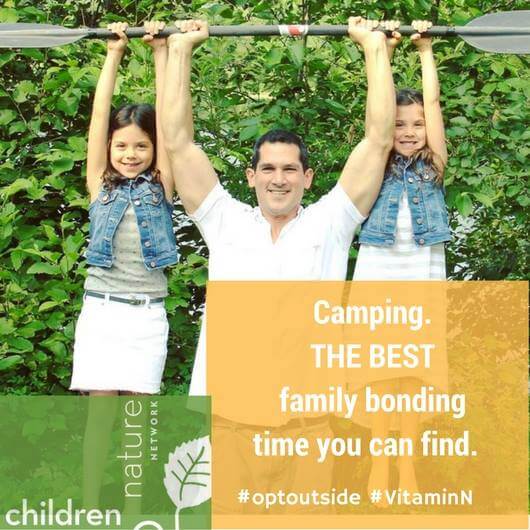 1. View nature as an antidote to stress. All the health benefits that come to a child come to the adult who takes that child into nature. Children and parents feel better after spending time in the natural world-even if it’s in their own backyard.
1. View nature as an antidote to stress. All the health benefits that come to a child come to the adult who takes that child into nature. Children and parents feel better after spending time in the natural world-even if it’s in their own backyard.
2. Lose the cell phone; get a better connection. Tech isn’t the enemy, but it can certainly be a barrier. Vow to periodically leave your cell phone in your pocket, ringer off, cancelling all the beeps, tweets, and repeats, so you’re more present with your child. Limit access to texting, computers, and TV part of the day or week. For example, schedule Friday as a “Smartphone and iPad-Free Outdoor Play Day” for the kids and the parents as well.
3. Go further—plan a techno-fast/vacation. Commit to a few days away from digital life. On your own or with kids, go camping, rent a cabin, or house–trade with someone who misses traffic jams. When my wife, Kathy, and I head out, I set my computer to send out this e-mail auto-reply: “I’m taking a brief break from all communications electronic . . . OK, here goes. Pulling the plug . . .” For emergencies, we bring Kathy’s not-so-smart flip phone but leave it in the car. By the fourth day, our sleep patterns return to normal. The world waits.
4. Put together a family G.O. Bag. Stuff a duffel bag with daypacks, a compass, binoculars, nature guides, and maybe a topo-map of your bioregion. Add granola bars, hats, gloves, fleece vests, sunglasses, collapsible hiking poles, some old hiking shoes or other comfortable footwear, and water bottles. Wrap your G.O. Bag. Stash it in your car trunk. Now your family can Go Outside on a moment’s notice. (This is also a safety precaution for fires and other natural disasters.)
5. Start or Join a Family Nature Club. Here’s a way to create a community of support for parents and children: join an existing family nature club, or form a new one. It’s a great way to create a community of support for families. This same concept can be adopted by teens or adults without children of their own, in the form of friendship nature clubs. Download a free toolkit (available in multiple languages) from C&NN.
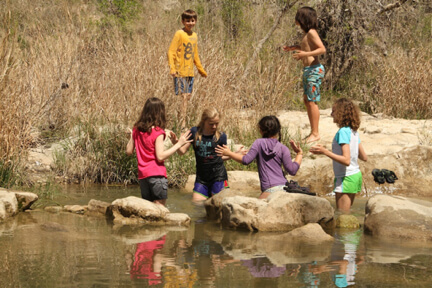 6. Establish a Parent-Teacher Nature Club. Robert Bateman, the renowned Canadian artist, whose paintings often depict wildlife, suggests that teachers and other educators create their own Teacher Nature Clubs to organize weekend hikes and other nature experiences for teachers. Go further: create a Parent-Teacher Nature Club. (Call it the PTN. In fact, your PTA could take the lead and create a PTN.) Such clubs would encourage teachers experienced in the natural world to share their knowledge with teachers less experienced in the outdoors.
6. Establish a Parent-Teacher Nature Club. Robert Bateman, the renowned Canadian artist, whose paintings often depict wildlife, suggests that teachers and other educators create their own Teacher Nature Clubs to organize weekend hikes and other nature experiences for teachers. Go further: create a Parent-Teacher Nature Club. (Call it the PTN. In fact, your PTA could take the lead and create a PTN.) Such clubs would encourage teachers experienced in the natural world to share their knowledge with teachers less experienced in the outdoors.
7. Don’t cut down the tree, build up the kid! Provide training in the value and management of natural risk. Teachers, play leaders (or “playworkers” as they’re called in the UK), and parents who supervise groups of children need regular training in play leadership. “Such training has been successful in adventure playgrounds, and limited numbers of forest schools, zoos, child development centers, children’s museums and expanding integrated natural/built playgrounds at schools and parks,” says international play expert Joe Frost. Common sense helps. But up-to-date knowledge about play and risk is essential.
8. Make every school a “green haven.” In the public mind, schools are too often associated with stress and even violence. One way to change that perception is to turn them into “green havens,” writes Louise Chawla, professor of environmental design, University of Colorado in Boulder, and coeditor of the journal Children, Youth and Environments. “Not every family has natural areas around their home or a park down the block, but almost every family sends their children to a school where there is a playground or playing fields.” She recommends turning parts of school grounds into gardens, natural habitats for study and play. “Then all children could have a green haven in their lives. A place for calm, peace, and rapt absorption.”
Challenge your whole city to become the most nature-rich city in the nation — and emphasize equity.
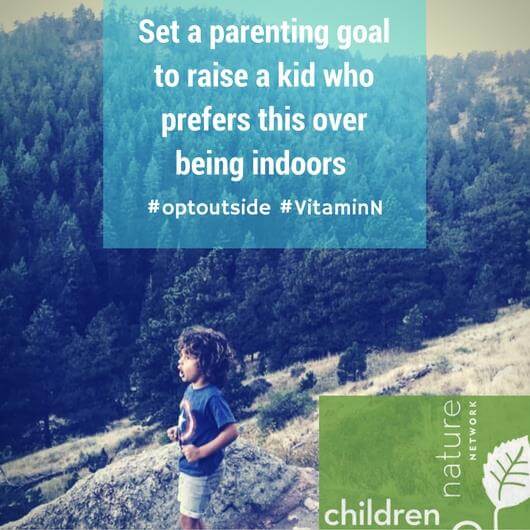 9. Work for natural equity. Every child has a right to experience the natural world, not just those of a certain economic or cultural group or set of abilities, not just those with parents who encourage nature play and nature learning. Every child. Start or support a regional campaign to connect all children to nature in the city or county in which you live. Bring pediatricians and educators, business people and conservationists, liberals and conservatives, places of worship and service organizations together to reduce nature-deficit disorder in every neighborhood.
9. Work for natural equity. Every child has a right to experience the natural world, not just those of a certain economic or cultural group or set of abilities, not just those with parents who encourage nature play and nature learning. Every child. Start or support a regional campaign to connect all children to nature in the city or county in which you live. Bring pediatricians and educators, business people and conservationists, liberals and conservatives, places of worship and service organizations together to reduce nature-deficit disorder in every neighborhood.
10. Champion the return of recess and other school programs that get kids outside. Engage your PTA and other organizations to help bring back recess and physical education — and then go the next step: encourage outdoor exercise and learning. In addition to improving physical and mental health, outdoor time can raise test scores. And now for something completely different: though the approach is still rare, some high schools now allow student athletes to letter in outdoor sports, such as hiking and fishing.
11. Exert parent power. Parents can demand nature-rich education and have more influence to achieve that goal than they may believe. “School board members, trustees, administrators, and teachers listen to parents big-time,” says Tim Grant, editor in chief of the Canada-based journal Green Teacher. “Many teachers have said they’ve made suggestions to principals and received no response, but when the parent makes the same suggestions, things often start to happen” at the national, state, and local levels. Push to enact bills supporting environmental education in the classroom and outdoor experiential learning. Beyond schools, encourage your pediatrician to prescribe nature.
12. Put nature on the calendar. If you plan the family’s sports commitments and vacations in advance, do the same for time spent in nature. Try skipping organized sports for a season and use that time to get outside. That suggestion won’t work for everyone, but for busy parents, teachers and community leaders, taking time for nature requires making time, and putting it on the calendar.
-
Network News
POLICY UPDATE: Policy and advocacy for the children and nature movement
-
Voices
Binoculars, bald eagles and my journey as a Black birder
-
Richard Louv
THE WONDER BOWL: Ten Spring and Summer Nature Activities for Kids and Adults
-
Network News
Minneapolis Spotlight: The promise and possibilities of parks for youth
-
Voices
Why nature is my motherhood ally




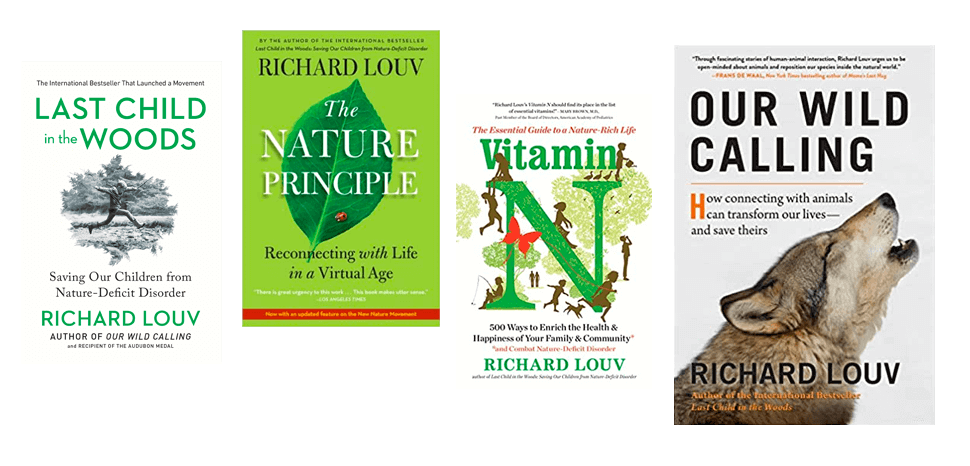
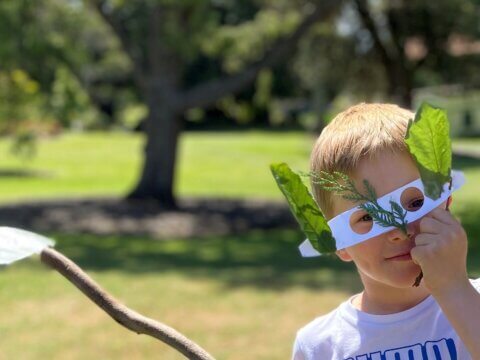

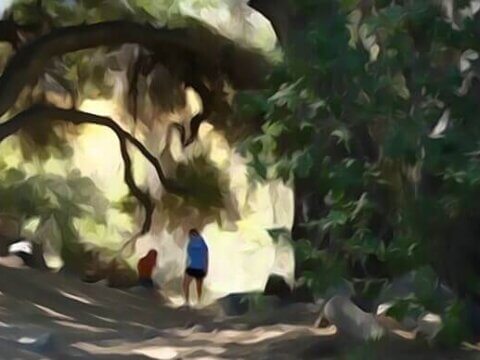
Commentaries on the C&NN website are offered to share diverse points-of-view from the global children and nature movement and to encourage new thinking and debate. The views and opinions expressed are those of the author(s) and do not necessarily reflect the position of C&NN. C&NN does not officially endorse every statement, report or product mentioned.